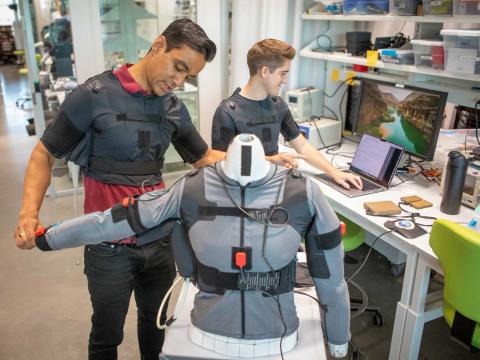Air Force Seeks Disaggregated Command and Control
A combination of artificial intelligence, machine learning, cloud computing, fifth-generation communications and agile software development processes may one day allow commanders to direct any asset from anywhere, essentially revolutionizing command and control.
During the recent AFCEA Alamo Chapter Event in San Antonio, several officials agreed that the current command and control (C2) center known as an air operations center (AOC) has grown too cumbersome and vulnerable for Air Force commanders to make the rapid-fire decisions required in the modern era of multi-domain operations.
Maj. Gen. Patrick Wade, USAF, mobilization assistant to the Air Combat Command commander, pointed out that the AOC can take up to 72 hours to complete an air tasking order, which essentially assigns specific aircraft to a mission. “I think in the future, and I say think, we’re going to be fusing information from fifth-gen platforms, bringing together everything we have in the Air Force, in other services and with our coalition partners, and trying to take that data and turn it into something actionable.” He added that artificial intelligence (AI) or “some kind of fusion cell” will process the vast amounts of information and provide access to “all services, all components, all domains.”
Gen. Wade also suggested the air tasking order process needs to be streamlined from days to hours or even minutes to outpace future adversaries. “That’s a tall order,” he admitted.
When asked whether a single entity, such as an AOC, is capable of synchronizing multidomain operations in a conflict with a peer adversary, Col. Brian Tyler, USAF, chief of Cyber and Non-Kinetic Operations Division at Air Combat Command, replied, “Absolutely not.”
He went on to say that a 1500-person AOC is “incapable of mastering all domains” and doing so “at a pace of execution expected of multidomain operations of tomorrow.”
Col. Tyler suggested that some C2 responsibilities may be delegated to lower levels, such as company commanders. “We have to increasingly think about how we disaggregate that,” he said.
Col. Johnathan Hughes, USAF, chief, Command and Control, Intelligence, Surveillance and Reconnaissance Operations Division, Air Combat Command, agreed. “What we’re looking at now is to disaggregate functions into applications on a common platform. The common platform allows me to do C2 from anywhere. Putting it in the cloud allows me to not have the hardware or the software physically where I’m at. I just need a browser to dial into it,” Col. Hughes said. “I need to be able to C2 multiple things from different places all in real time and all talking to each other so that we’re going to be integrated rather than synchronized.”
One of the challenges for the Air Force, the other services and the entire Defense Department, is sorting through the massive amounts of data now available. “We’re in a world where I’ve got so much information that I don’t know what’s relevant and what isn’t,” Col. Hughes said.
Multiple officials offered AI or machine learning as a major part of the solution for the drowning-in-data problem. “AI will synchronize all of the data while next-generation communications or cloud computing make the data accessible to create some level of shared battle space awareness,” Col. Tyler said.
Col. Hughes also stressed the importance of communications. “The basis of C2 even now is communications. The infrastructure that we need to do C2 in the future is going to be key, and that is where the enabler is going to come from,” he said.
He added that the 1500-person AOC presents one big target. “If we’re posing dilemmas to the enemy, having all of our important C2 in one space and giving them three days between each new set of problems is probably not the answer. That is not the future.”
But disaggregated C2 also poses challenges for the communications infrastructure, he indicated. “What I need is a communications infrastructure, a data infrastructure, because while I’m disaggregating my C2 nodes, I need all of those different nodes to access the same data simultaneously from different parts,” Col. Hughes elaborated. “While I’m disaggregating my physical C2 nodes, what I need to do is aggregate my data.”
He also emphasized the need for data security. “I need to secure that because I’m taking all my people out of one central place, but I need to put all my data, metaphorically speaking, into a central place that I can access from the different areas,” Col. Hughes stated.
Col. John Galik, chief, Personnel Recovery and Joint Integration Division, Air Combat Command, described a future in which commanders will know the enemy’s doctrine and will be able to model an adversary’s network environment, ground maneuver forces and air power in order to better understand the adversary’s most likely, or most dangerous, course of action. At the same time, commanders will be able to model friendly force capabilities and know where those forces are located and which units are combat-ready. Commanders will be able to model those so-called blue force capabilities as well.
“With this modeling information, what I would want is AI, or machine learning, at some level to be able to connect the dots very, very quickly,” Col. Galik said.
The AI will be able to predict, for example, that an enemy commander under certain conditions will “change his network environment sometime in the next 12 minutes” and “when he does, there will be a window of opportunity to do something in the ground domain, which will open up a window of opportunity for an airstrike on some other key node, and it has to be done sometime in the next 12 minutes,” Col. Galik added.
The capability could offer a tremendous advantage. “The next great leap is the resource, the capability, to make those decisions at the speed that overwhelms our competitor,” Col. Galik offered.
Col. Tyler agreed that the vision represents a major leap over today’s capabilities. “We struggle just knowing what blue networks look like today just to get established configuration control. To truly understand blue networks and to truly understand red space and to know physically where those linkages are that might enable us, in essence, a counter C2 warfare executed in a very compressed window of time is an enormous challenge.”
However, Col. Galik warned of a so-called second-order effect. “In creating this new capability to help us make decisions, we also create a significant information attack surface. All of the modeling I spoke about, all of that is going to live somewhere. It’s all going to be information dependent. That avenue of attack on our information—where we store it, how we store it, how we gather it—that surface becomes bigger as we get into this AI-enabled world.”
Col. William Hill II, USAF, director of strategy, plans and engagements, 24th Air Force, indicated that another challenge lies in providing data from the tactical edge to higher echelons and to everyone else who might need it. “I don’t think we have the answer yet. We have a lot of things teams are working on so that there may not be a central location for the data, but some place accessible by all,” he said.
Software DevOps is also critical to the disaggregated C2 vision. Traditionally, the military has struggled to develop and field software before it is obsolete. “In the past, we wanted one piece of software that did everything from strategy to combat plans to combat ops, and they all talk to each other, and it’s all integrated, which is great if I’ve got 10 years to develop it and field it. And again it’s going to be obsolete, and it’s going to be one freaking target for the bad guy,” Col. Hughes vented. “What you get is yesterday’s technology at tomorrow’s prices.”
Col. Hughes cited the Theater Battle Management Core System, an integrated command and control, intelligence, surveillance, and reconnaissance system, which provides hardware, software and communications interfaces to support the preparation, modification and dissemination of the force-level air battle plan.
The Air Force is moving away from the system. “If anyone is old enough to remember when that came online, it’s horrible. It’s 1980s technology fielded in the ’90s or early 2000s, and we’re still using it,” Col. Hughes said. “We’re going to an app-based approach, a cloud-based approach. That means we can access the data from anywhere.”
The Air Force, and the military overall, no longer can afford to field software using traditional processes. “We need to stop that. If you’re taking years to acquire software, it’s already obsolete by the time you field it, and then you’ve got to work out all the bugs and then you’ve got this product that we’re locked into,” Col. Hughes stressed.
DevOps, on the other hand, allows cross-functional teams to work together, to streamline acquisition processes and to get technology to the field more rapidly. “The great thing about DevOps is that I don’t field software and walk away because I’m done. I field an app that does something better than the tool I’ve got right now, and I’ve got a team working with users constantly iterating upon that,” Col. Hughes explained.
The Air Force’s Program Executive Officer Digital and the Defense Innovation Unit are working to expand DevOps processes across the Air Force and across the Defense Department. The Program Executive Officer Digital has its roots in the Kessel Run program, an early DevOps effort during which the Defense Innovation Unit helped develop planning software for tanker aircraft. Using the software, one person can accomplish in three hours on a touch-screen a task that once took six people eight hours using magnets and markers on a whiteboard.
Col. Hughes said the Air Force has multiple projects in the works to make disaggregated C2 a reality, but he noted that even with DevOps processes, the vision might take a while. “It’s probably not a matter of days or weeks. It’s probably a couple of years off, but we’re investigating some exciting new technologies both in AI and in communications.”






Comments